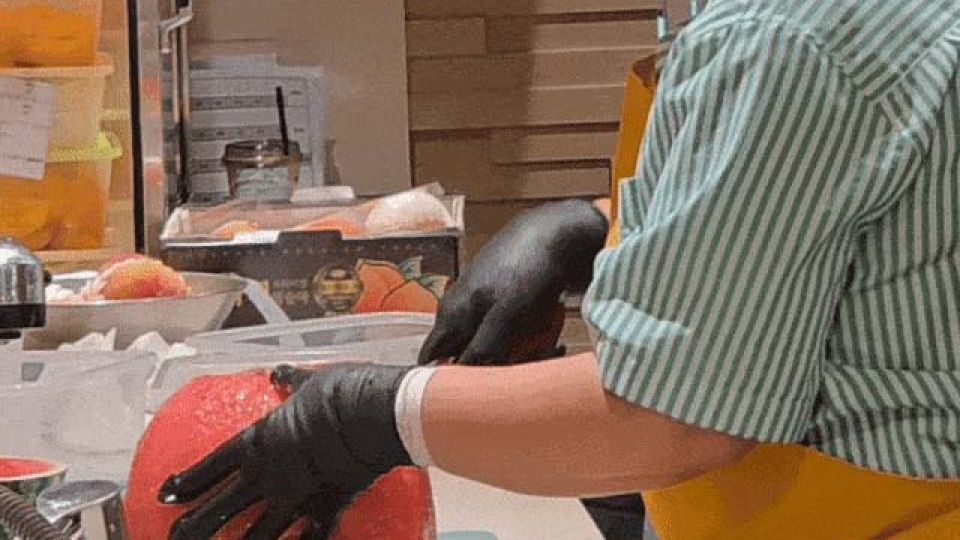July 25, 2025
SEOUL – At Hyundai department stores in Seoul, long lines are nothing new. Shoppers regularly queue for designer handbags or the latest dessert trends. But this summer, one of the longest lines is for the watermelon — or more precisely, to have it cut.
At seven Hyundai locations, including The Hyundai Seoul in Yeouido, customers wait for hours to have their fruit sliced and packed into containers, ready to be eaten or stored in the refrigerator.
The service, called “Fresh Table,” was launched in 2021 as Korea’s first in-store station dedicated to slicing fresh fruits and vegetables.
Customers must first purchase the fruit. If they don’t bring their own container, they can buy one at the store. After that, they bring the fruit, along with the receipt, to the Fresh Table to have it cut. The service quickly gained popularity, especially among watermelon lovers.
According to Hyundai Department Store, weekend wait times can stretch to two or three hours and sometimes even longer. That’s why some customers rush to grab an online queue ticket the moment the doors open.
Staff at the seven branches are slicing up 600 to 700 whole watermelons each day throughout July, a Hyundai Department Store official said.
When a Korea Herald reporter visited the Yeouido branch at around 2:30 p.m. last Sunday, a member of staff approached almost immediately.
“Are you here for the cutting service?” she asked. When the reporter said yes, the employee replied, “Did you check the wait time? It’s a few hours.”
She wasn’t exaggerating. A nearby sign showed an estimated wait of 2 hours and 40 minutes.
For many, it comes down to convenience.
Yoon Seo-young, a 36-year-old mother from Yeongdeungpo-gu, Seoul, came to wait with her husband and toddler after hearing about the service from a friend.
“I waited a little over two hours. I could shop while waiting so it was not a big deal,” she said. “The watermelons here are already sweet and tasty, but having the cutting service is even better. When you’re raising a child, one less chore makes a big difference.”
She added that it also saves her from dealing with bulky food waste.
“Usually, the rinds take up more than half of a 5-liter food waste bag. It’s annoying. Now I can just take it home and eat it.”
Im Bo-min, 40, who has used the service several times, said she especially likes being able to customize how it’s cut.
“I usually have half chopped into cubes and the other half left in big chunks,” she said. “The cubed pieces release too much water too quickly. I actually got this tip from a moms’ online community.”
At Hyundai, you have to buy a whole watermelon to use the cutting service, which is why you’ll often see people online looking for someone to split one with.
Despite the large portion, Im said it’s still worth it.
“Other places sell smaller packs of pre-cut watermelon, but they’re not as fresh,” she said. “Here, you can actually see them cutting it, and that makes a difference.”
Even those who didn’t end up using the service showed interest.
Around 4 p.m., a man in his 50s, surnamed Kim, stopped in front of a display of pre-cut watermelon at the station, assuming he could buy it right away. After hearing about the wait time, he shook his head.
“I have dinner plans, so I can’t stay,” he told The Korea Herald. “But I’ll come back. My wife loves watermelon, and honestly, cutting it at home is kind of a hassle.”
Jung Ji-young, 35, said she skipped the service because of the price.
“It costs over 50,000 won ($36) with the container. That’s almost double what I’d pay at a local discount store,” she said. “My husband said he’d ‘sacrifice’ and cut it himself. But I get why people line up for the service. If it were cheaper, I’d probably do it too.”
A Hyundai Department Store official also said the service has been particularly popular among households with children and single-person households, both of which value convenience and find it difficult to handle bulky food waste.
“In fact, fruit and vegetable sales at branches with Fresh Table have increased more than twice compared to those without it,” the official said.
Hyundai isn’t the only player riding the wave of selling fruit in a more convenient, ready-to-eat form.
Across Korea, convenience stores, neighborhood fruit stands and online grocers are rolling out their own ready-to-eat fruit options, often in small portions ideal for one or two servings.
“I once ordered pre-cut watermelon from Kurly (the online grocery platform). I loved how convenient it was, and it was just the right amount for two servings,” said Choi Hee-jung, 32. “Since I live alone, I can’t imagine buying a whole watermelon, let alone dealing with the hassle of cutting it.”
Jang Hye-jin, 29, who also lives alone, echoed the sentiment.
“I rarely buy whole fruit. But sometimes I order a small pre-cut pack from a local fruit shop. It’s pricey, so I can’t do it often. But when I think about how much I’d waste buying a whole one, the cost feels worth it.”
Just this past Sunday, Shinsegae’s convenience store chain Emart24 announced a new partnership with OROT, a local fruit vending machine brand.
Together, they launched “Pinkkio,” a smart fridge stocked with freshly cut fruit in small portions, now being tested at select Emart24 stores.
“The move reflects changing consumer habits,” an Emart24 official said. “With more people living alone and prioritizing convenience, demand for smaller fruit portions has grown.”
According to Emart24 data, small-portioned fruit sales at Emart24 rose steadily in the second quarter of this year, up 10 percent in May from April, and another 15 percent in June.


